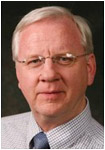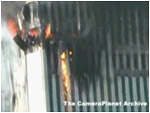 Dr. Steven E. Jones, the physics professor at Brigham Young University in Utah who coined the term "cold fusion", has become a key figure amongst 9/11 researchers and enthusiasts alike with his study on the probability of thermite being used in the destruction of the World Trade Center buildings 1, 2 & 7. His conclusion was initially inspired by several pieces of evidenciary information including the discoveries of pools of molten steel found in the sublevels of all three buildings, video footage of each collapse, and footage of what appears to be a thermite reaction on the corner of one of the towers moments before collapse. His hypothesis was solidified when scientific analysis was done on soil which had been cleaned off of one of the WTC beams before it was placed on a 9/11 memorial site. This analysis brought Jones to the conclusion that Dr. Steven E. Jones, the physics professor at Brigham Young University in Utah who coined the term "cold fusion", has become a key figure amongst 9/11 researchers and enthusiasts alike with his study on the probability of thermite being used in the destruction of the World Trade Center buildings 1, 2 & 7. His conclusion was initially inspired by several pieces of evidenciary information including the discoveries of pools of molten steel found in the sublevels of all three buildings, video footage of each collapse, and footage of what appears to be a thermite reaction on the corner of one of the towers moments before collapse. His hypothesis was solidified when scientific analysis was done on soil which had been cleaned off of one of the WTC beams before it was placed on a 9/11 memorial site. This analysis brought Jones to the conclusion that it was not just thermite that was used, but a specific type called Thermate--a mixture which is used almost exclusively for structural demolition. An updated version of his paper Why Indeed the WTC Buildings Collapse? can be found here. it was not just thermite that was used, but a specific type called Thermate--a mixture which is used almost exclusively for structural demolition. An updated version of his paper Why Indeed the WTC Buildings Collapse? can be found here.
Dr. Jones was a featured speaker at the American Scholars Symposium: 9/11 + The Neo-Con Agenda in Los Angeles, CA in June of 2006 which was broadcast nationally on C-SPAN several times. He also co-chairs Scholars for 9/11 Truth and is co-editor of the Journal of 9/11 Studies. Education In 1973, Jones earned his bachelors degree in physics, magna cum laude, from Brigham Young University, and his Ph.D. in physics from Vanderbilt University in 1978. Jones conducted his Ph.D. research at the Stanford Linear Accelerator Center (from 1974 to 1977), and post-doctoral research at Cornell University and the Los Alamos Meson Physics Facility. Research interests and background Jones conducted research at the Idaho National Engineering Laboratory, in Arco, Idaho, from 1979 to 1985, where he was a senior engineering specialist. He was the principal investigator for experimental Muon-catalyzed fusion from 1982 to 1991 for the U.S. Department of Energy, Division of Advanced Energy Projects. From 1990 to 1993, Jones researched fusion in condensed matter physics and deuterium, for the U.S. Department of Energy and for the Electric Power Research Institute. Jones has also been a collaborator in several experiments, including experiments at TRIUMF (Vancouver, British Columbia), The National High Energy Laboratory, KEK (Tsukuba, Japan), and the Rutherford Appleton Laboratory at Oxford University. Jones specializes in Metal-catalyzed fusion, Archaeometry and Solar energy. Jones has written a paper entitled "Behold My Hands: Evidence for Christ's Visit in Ancient America" in which he used archeological evidence to support the claims of Joseph Smith Jr. (founder of the Latter Day Saint movement) that Jesus had visited the Native Americans after his Resurrection, an event chronicled in the Book of Mormon. The evidence pointed to is Mayan depictions of deities which have stigmata like markings on their hands. Cold fusion In the mid-1980s, Jones and other BYU scientists worked on what he then referred to as Cold Nuclear Fusion in a Scientific American article, but is today known as muon-catalyzed fusion to avoid confusion. Muon-catalyzed fusion was a field of some interest in the 1980s, but its low energy output appears to be unavoidable and the field has since fallen from interest. Around 1985 Jones then became interested in the anomalous production of helium-3 found in the gasses escaping from volcanoes. He hypothesized that the high pressures in the Earth's interior might make fusion more likely, and began a series of experiments on what he referred to as piezofusion, or high-pressure fusion. His experiments initially used a diamond anvil to create high pressures, but he later moved on to an apparatus similar to the one also used by Stanley Pons and Martin Fleischmann. In order to characterize the reactions, Jones designed and built a neutron counter able to accurately measure the tiny numbers of neutrons being produced in his experiments. The counter suggested a small amount of fusion was going on. Jones said the result suggested at least the possibility of fusion, though the process was unlikely to be useful as an energy source. Pons and Fleischmann (P&F) started their work around the same time. Their work was brought to Jones' attention when they applied for research funding from the Department of Energy and they passed their proposal along to Jones for peer review. Realizing their work was very similar, Jones and P&F agreed to release their papers to Nature on the same day, March 24, 1987. However, P&F announced their results at a press event the day before. Jones faxed his paper to Nature. A New York Times article says that while peer reviewers were quite critical of Pons and Fleishchmann's research they did not apply such criticism to Jones' much more modest, theoretically supported findings. Although critics insisted that his results likely stemmed from experimental error, most of the reviewing physicists indicated that he was a careful scientist. WTC collapse hypothesis Jones has written a paper regarding the September 11, 2001 attacks, entitled "Why Indeed did the WTC Buildings Collapse?". In his paper, Jones cites what he considers evidence which he believes supports the hypothesis that the World Trade Center was brought down, not by impact damage and fires, but through the use of pre-positioned cutter-charges and thermite. Jones has compiled a presentation, "Answers to Objections and Questions," in which he seeks to answer objections and detail certain aspects of his views. With regard to his findings, Jones says they are "compelling to many, but one needs to be cautious until results are checked and published in a peer-reviewed journal." He also says "It is important scientifically to have an independent analyses performed, to verify the presence of thermite signature chemical elements. And to publish results in a peer reviewed journal. Realistically, both groups will probably need to submit simultaneously to be published in a major journal like Nature." |